Any devoted technology enthusiast will find himself familiar with CR2450, a high-performance and non-rechargeable battery that works best in remote controls, motherboards, flashlights, and LEDs. However, its exceptional performance and steeping price mean this battery is not always accessible. What to do then?
Here is when we step in, gladly delivering you some options for the best CR2450 battery equivalent! Let’s pitch these batteries against the powerful CR2450 for a more comprehensive evaluation.
All You Need to Know About CR2450 Batteries
1. Specifications

The CR2450 batteries boast 5.0 mm (0,197 inches) in height and 24.5 mm (0,964 inches) in diameter. Their weights differ across models, running from 5.7 to 6.4 grams (around 0.2 to 0.222 ounces).
Aside from that, these cells feature negative electrodes composed of lithium, accompanied by positive electrodes stemming from manganese dioxide, which explains the starter “CR” in their labels.
As you might have guessed, “CR2450” serves as a standard title for all lithium 2450 batteries with positive manganese-dioxide electrodes. Still, other labels are sometimes adopted; CR2450EL, CR2450EL, CR2450, CR2450N, ECR2450, DL2450, and 5029LC are cases in point.
People use this coin cell battery for watches, calculators, electronic devices, or healthcare devices.
2. Accompanied Feature: Soldering Tabs
Several CR2450-operated devices have soldering tabs to fuse these batteries to the motherboards.
We cannot deny that, in theory, you may solder the tabs directly onto BR or CR batteries without any filters. Nonetheless, if not properly executed, such moves might overheat your cell, leading to damage and shortened lifespan.
Hence, using soldering tabs fused by your manufacturers is still advisable. These bars are either inserted before or after battery assembly via a ‘cold’ soldering process (such as ultrasonic soldering). Sometimes, it might be both!
3. Safety Level
Just like most lithium coin batteries, CR2450 might be harmful upon swallowing.
No, that is not due to any toxic elements; after all, this coin cell battery has earned favorable feedback thanks to its absence of cadmium, lead, mercury, and heavy metals. The main issue lies in its electrolysis, which might pave the way for burns and internal injuries.
Even though some brands categorize their C-R2450 batteries in “child-safe” packages, you should keep them away from your pets and kids just in case.
Suppose your kid ingests a battery – whether CR2450 or any similar model; immediately contact a provincial emergency center and follow their instructions.
What Is The Possible CR2450 Battery Equivalent?
BR2450, LiR2450, CR2430, CR2477, and CR2032 are 5 candidates for CR2450 replacements.
Now, let’s see which CR2450 battery replacement can fare against the CR2450 itself in terms of performance and quality. Though they might not be as great, you can always turn to these options in case CR2450 is not an affordable purchase for you.
1. BR2450 vs. CR2450
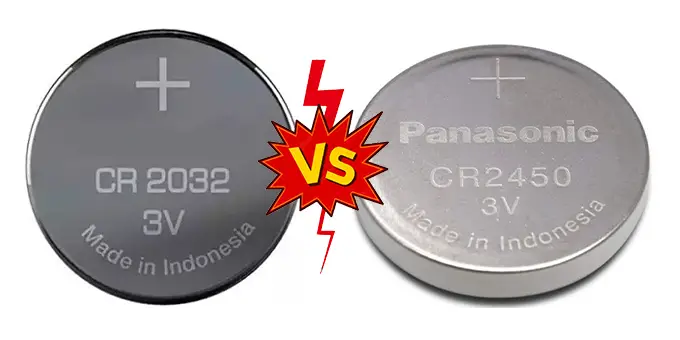
Given technological difficulties, it is quite rare to spot a 2450 battery with positive carbon-monofluoride electrodes. Still, these batteries do exist – in the form of the BR2450 and other “BR” cells!
These lithium carbon-monofluoride batteries set themselves apart by their consistent output voltage and low discharge rate. Still, these benefits are a bit lagging compared to CR2450 lithium batteries.
To be more specific, for starters, they fail to offer heightened discharge currents for remote controls, non-key entry systems, and other gadgets. Furthermore, their capacity – though impressive (500 to 550 mAh) – still has miles to catch up with CR2450 variants with their 600 to 620 mAh volume. Even old models of CR2450 could still reach 540 to 580 mAh, much better than BR2450.
However, that does not signal a complete defeat for BR2450. Its shell life can extend to at least ten years – thrice the lifespan of CR2450 (only three years). For customers who value durability, it seems BR2450 is a terrific choice!
Overall, despite their inferiority to CR2450 in capacity, discharge current, and accessibility (BR2450 is quite a challenge to find in stores these days), BR2450 could still serve as a direct replacement.
One note, however: some brands label these two models interchangeably to imply that they can substitute each other. Make sure to inspect their shell life carefully before making your purchase.
2. LiR2450 vs. CR2450
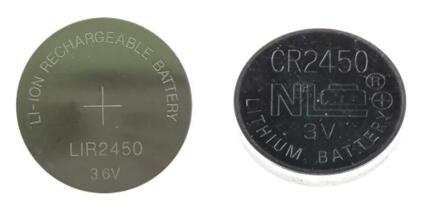
LiR2450 refers to 2450 rechargeable batteries. Their nominal voltages vary across different chemistry formulas, fluttering among 3.7, 3.6, 3.2, and 3.0 volts. Let’s delve into the performance of each.
- 3.0V: These cells can serve as a direct substitute for CR2450 models. They have similar output voltages that never surpass 3 volts, posing no danger to any sensitive electronics.
- 3.2V: These cells often boast a chemistry formula of LiFePO4 (or Lithium Iron Phosphates). Their output voltage is only slightly larger than 3-volt batteries but still delivers great risks for sensitive devices. Thus, never forget to check the gadget’s manual before inserting 3.2V cells into their systems.
- 3.6V to 3.7V: Their main components are a combination of several lithium-ion chemistries.
As a result, they have a much higher voltage than CR2450, calling for a thorough inspection before any usage. The voltage gap is more than sufficient to cause irreparable damage to your powered device, especially security and medical instruments, which require a consistent operation.
On another note, all three options have an output range of 100 to 125 mAh, meaning their recharge frequencies can reach a whopping amount of 800 times!
In general, although their self-discharge rating is quite excessive (up to 5% per month, while a high-quality CR2450 only has a 1% rate or less), they can help save some pennies for high-energy devices. Just remember to never pair them with any charger other than the one recommended by your manufacturers.
3. CR2430 vs. CR2477 vs. CR2450
All three are 3V non-rechargeable batteries with the same 23mm diameter (around 0.945 inches); thus, they are placed in the same category. But of course, these models bear different labels for a reason!
For starters, their heights differ, which are 3,0, 7.7, and 5.0 (0.118, 0.303, and 0.197 inches), respectively. This distinction leads to a gap in nominal capacity among battery 2430 vs. 2450 vs. 2477:
- CR2430: 270 to 290 mAh
- CR2477: around 1000 mAh.
- CR2450: 600 to 620 mAh
As you can see, CR2477 has the greatest capacity out of all options, which means it will undergo the longest operation period. In compensation, these durable batteries may last for years to come, saving you from extra expenditures.
(But of course, if lifespans are not your priority, feel free to opt for the low-energy CR2430 instead).
Even better, some gadgets feature battery compartment inserts, meaning you can power them using all three options – or just two – with no contact issues!
4. CR2450 vs CR2032
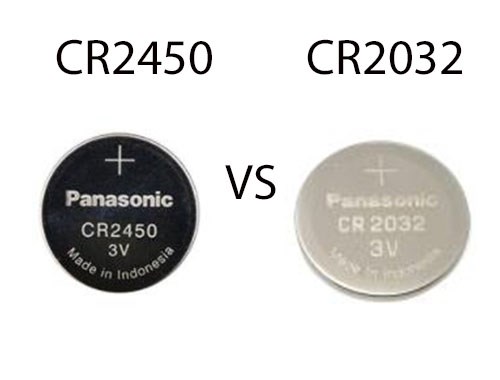
Another popular comparison is between CR2450 and CR2032 batteries, an equally well-known 3V coin battery. Due to the similar chemistry types and storage technology, their output voltages are more or less equal.
Still, CR2450 is superior by a long shot when it comes to volume thanks to the larger size. As mentioned several times above, its capacity is roughly 600 to 620 mAh. On the other hand, the CR2032 type stays far behind, only from 210 to 230 mAh. The 3x difference is why CR2450 is still the ultimate choice for high-drain devices.
It is true that certain machines incorporate special battery holders to accommodate both models concurrently. Yet, the performance gap between them makes CR2032 batteries barely leave behind any remarkable impact.
So, are CR2450 and CR2032 interchangeable in usage? Well, not really. Of course, the CR2032 counterparts are not half bad, but we still suggest you opt for CR2450 if possible.
What Are The Best CR2450 Brands?
As you may see, some of the recommended alternatives above – despite their stellar performances in certain facets – can not gain a complete victory over CR2450. Hence, we understand if you might still want to choose C-R2450 at the end of the day.
Popular names like Energizer, Sony, and Panasonic instantly come to mind when it comes to some of the most trustable names.
Their batteries run on 600 to 620 mAh, enjoying at least seven years of shell life and easily withstand 3 mAh in discharge currents. Most importantly, their accessibility is a plus; you may spot them in a blink from any online or retail shop!
1. Panasonic
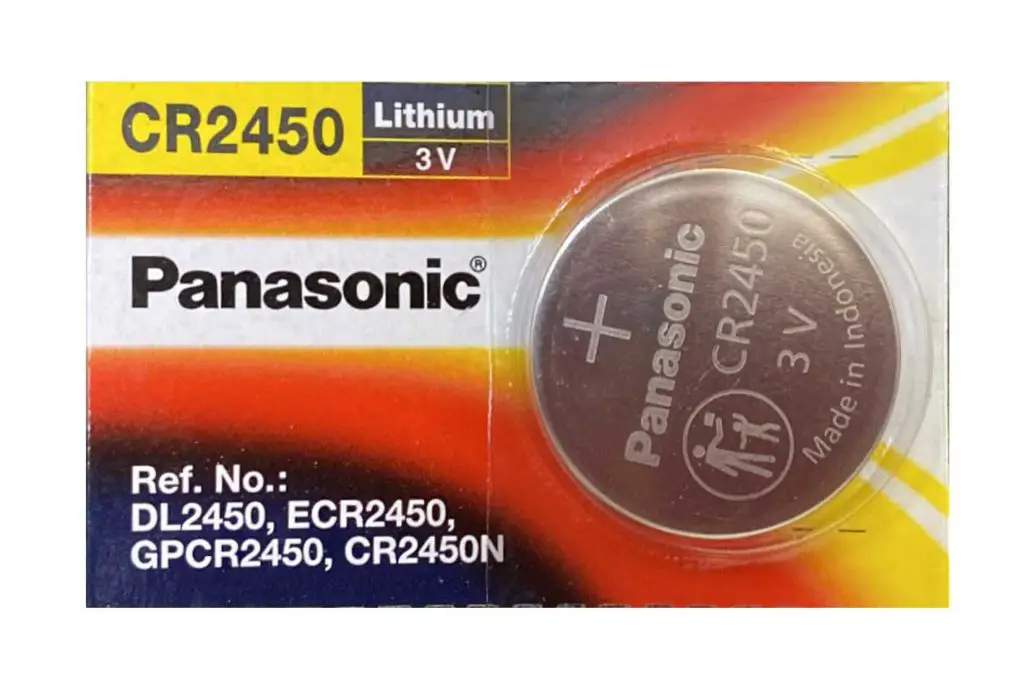
Panasonic 3V non-rechargeable lithium C-R2450 batteries – commonly termed CR2450 EL – can work well in temperatures from -22°F (around -30°C) to 140°F (approximately +60°C).
Its standard drain is around 0.42 mA, accompanied by an average weight of 6.4 grams, which is quite compact! There is no mercury contained, and they rarely leak during operation.
When it comes to nominal capacity, a Panasonic button cell battery boasts a volume of 620 mAh – though the estimations might shift depending on the device’s cutoff voltage.
As a result, they garner positive reviews due to long shell lifespans and energy-saving discharge rates. In general, these cells still retain almost 90 percent of the original capacity after nine or ten years.
2. Sony
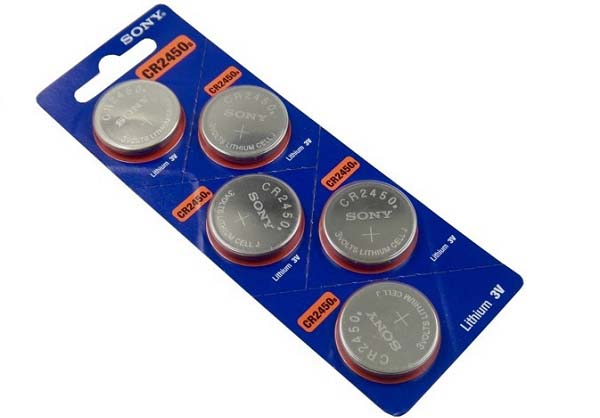
Sony is another well-recognized label. Its CR2450 batteries operate in temperatures of -22°F (nearly -30°C) to 158°F (around 70°C), with an annual discharge rate of only 1% at room temperature! Terrific for anyone looking for energy-saving alternatives.
Hence, just like their Panasonic counterparts, 90% of the capacity can still remain intact after ten years.
Moreover, with a nominal capacity of 610 mAh and standard drains reaching 0.2 mA, you can be certain that their performances are top-notch. To seal the deal, the cells incorporate leakage protection to save your devices from internal damage!
3. Energizer

Energizer cells are comparable to Panasonic and Sony in terms of specifications, so we will not delve further into that. Here is a quick summary:
- Capacity: 620 mAh
- Weight: 6.8 grams
- Self-discharge rate: 1%
- Operating temperatures: -22°F to 140°F (-30°C to 60°C)
- Continuous drain: 0.39 mA (29 volts)
After years of room-temperature storage, 80% of their nominal capacity can still be preserved. Even better, these batteries can hold against 9 mA drain for only 2 seconds, which is such a convenient feature for daily high-drain devices.
Conclusion
Our article has highlighted some possible contenders for the CR2450 battery equivalent. Most of them might be lacking in some attributes, but still decent enough to substitute a high-functioning CR2450 if necessary.
Nevertheless, do not forget to consult manufacturers or check the device’s manual before investing your money in these items. Otherwise, incompatible battery models may hamper the gadget’s performance, costing you a fortune for reparation









0 Comments